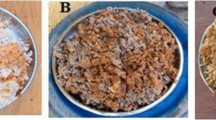Abstract
Ethanol was produced from very high gravity mashes of dry milled corn (35% w/w total dry matter) under simultaneous saccharification and fermentation conditions. The effects of glucoamylase dosage, pre-saccharification and Saccharomyces cerevisiae strain on the growth characteristics such as the ethanol yield and volumetric and specific productivity were determined. It was shown that higher glucoamylase doses and/or pre-saccharification accelerated the simultaneous saccharification and fermentation process and increased the final ethanol concentration from 106 to 126 g/kg although the maximal specific growth rate was decreased. Ethanol production was not only growth related, as more than half of the total saccharides were consumed and more than half of the ethanol was produced during the stationary phase. Furthermore, a high stress tolerance of the applied yeast strain was found to be crucial for the outcome of the fermentation process, both with regard to residual saccharides and final ethanol concentration. The increased formation of cell mass when a well-suited strain was applied increased the final ethanol concentration, since a more complete fermentation was achieved.



Similar content being viewed by others
References
D’Amore T (1987) Ethanol tolerance of yeast. Enzyme Microb Technol 9:322–330
Devantier R, Scheithauer B, Villas-Bôas SG, Pedersen S, Olsson L (2005) Metabolite profiling for analysis of yeast stress response during very high gravity ethanol fermentations. Biotechnol Bioeng (in press)
Dygert S (1965) Determination of reducing sugar with improved precision. Anal Biochem 13:367–374
Gustin MC (1998) Map kinase pathways in the yeast Saccharomyces cerevisiae. Microbiol Mol Biol Rev 62:1264–1300
Hounsa CG (1998) Role of trehalose in survival of Saccharomyces cerevisiae under osmotic stress. Microbiology 144:671–680
Ingledew WM (1993) Yeasts for production of fuel ethanol. In: Rose AH and Harrison JS (eds) The yeasts. Vol. 5. Yeast technology. Academic Press, Redding, pp 245–291
Jaques KA, Lyons TP, Kelsall DR (2003) The alcohol textbook, 4th edn. Nottingham University Press, Nottingham
Novozymes (2002). Application sheet: spirizyme plus for ethanol production. Novozymes, Bagsvaerd, Denmark
Olsen HS (1995) Enzymatic production of glucose syrups. In: Kearsley MW, Dziedzic SZ (eds) Handbook of starch hydrolysis products and their derivatives. Blackie, London
Oura E (1977) Reaction products of yeast fermentations. Process Biochem 12:19
Piper P (1995) The heat shock and ethanol stress response of yeast exhibit extensive similarity and functional overlap. FEMS Microbiol Lett 134:121–127
Searle BA, Kirsop BH (1979). Sugar utilization by a brewing yeast in relation to the growth and maintenance phases of metabolism. J Inst Brew 85:342–345
Thatipamala R (1992) Effects of high product and substrate inhibitions on the kinetics and biomass and product yields during ethanol batch fermentation. Biotechnol Bioeng 40:289–297
Thomas KC, Hynes SH, Ingledew WM (1993) Production of fuel alcohol from wheat by VHG technology. Appl Biochem Biotechnol 43:211–226
Thomas KC, Hynes SH, Ingledew WM (2001) Effect of lactobacilli on yeast growth, viability and batch and semi-continuous alcoholic fermentation of corn mash. J Appl Microbiol 90:819–828
Walker GM (1998) Yeast physiology and biotechnology. Wiley, Chichester
Acknowledgements
This work was carried out with financial support from the Danish Industrial PhD Fellowship Programme administered by the Danish Academy of Technical Sciences. Grith H. Andersen, Susanne Hønholt, Rikke Jensen and Anna C. J. Kristensen are thanked for practical assistance.
Author information
Authors and Affiliations
Corresponding author
Rights and permissions
About this article
Cite this article
Devantier, R., Pedersen, S. & Olsson, L. Characterization of very high gravity ethanol fermentation of corn mash. Effect of glucoamylase dosage, pre-saccharification and yeast strain. Appl Microbiol Biotechnol 68, 622–629 (2005). https://doi.org/10.1007/s00253-005-1902-9
Received:
Revised:
Accepted:
Published:
Issue Date:
DOI: https://doi.org/10.1007/s00253-005-1902-9




